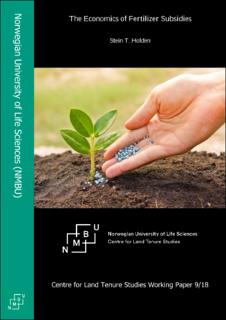| dc.contributor.author | Holden, Stein | |
| dc.coverage.spatial | Africa | en_US |
| dc.date.accessioned | 2020-02-18T11:48:41Z | |
| dc.date.available | 2020-02-18T11:48:41Z | |
| dc.date.issued | 2018 | |
| dc.identifier.uri | https://hdl.handle.net/11250/2642250 | |
| dc.description.abstract | Fertilizer and other input subsidies have been a prominent component of agricultural policies in many Asian and African countries since the 1960s. Their economic and political rationale is scrutinized with emphasis on the second generation of targeted input subsidy programs that were scaled up in Sub-Saharan Africa (SSA) after 2005. The extent to which they full-fill the goal of being ‘market smart’ is assessed after inspecting the potential for such subsidies in SSA. The new fertilizer subsidy programs do not live up the market smart principles and suffer from severe design and implementation failures. While a clear exit strategy was one of the key principles, this principle has been neglected with the result that most current programs are more ‘sticky’ than ‘smart’. They have only partially achieved the intended impacts and have resulted in a number of unintended negative impacts. Redesign should start from a pilot stage testing basic mechanisms. | en_US |
| dc.language.iso | eng | en_US |
| dc.publisher | Norwegian University of Life Sciences, Ås | en_US |
| dc.relation.ispartofseries | CLTS Working paper;9/18 | |
| dc.rights | Attribution-NonCommercial-NoDerivatives 4.0 Internasjonal | * |
| dc.rights.uri | http://creativecommons.org/licenses/by-nc-nd/4.0/deed.no | * |
| dc.title | The economics of fertilizer subsidies | en_US |
| dc.type | Working paper | en_US |
| dc.subject.keyword | Fertilisers | |
| dc.subject.keyword | Subsidies | |
| dc.subject.keyword | Economic competition | |
| dc.subject.keyword | Impact assessment | |

